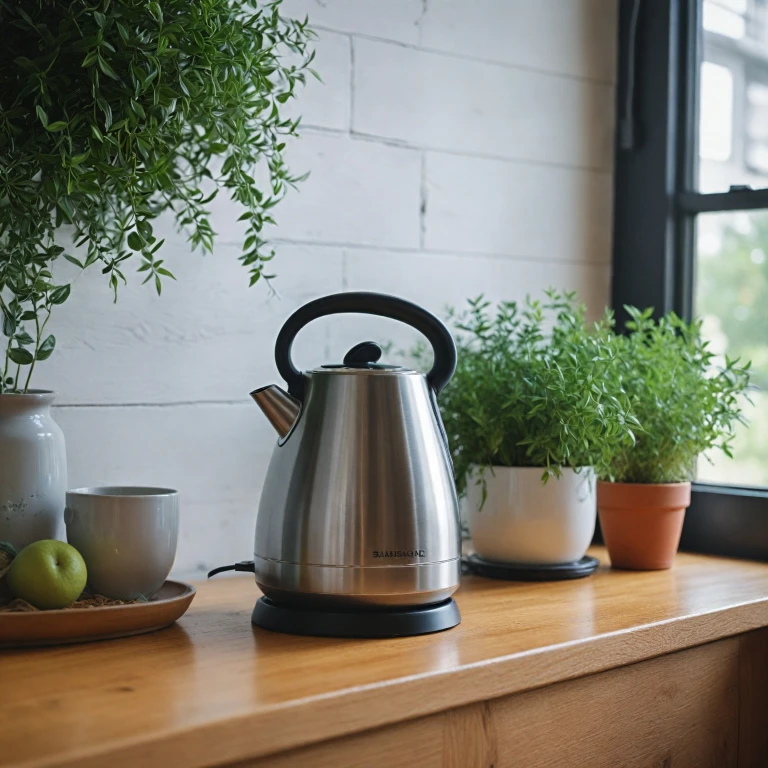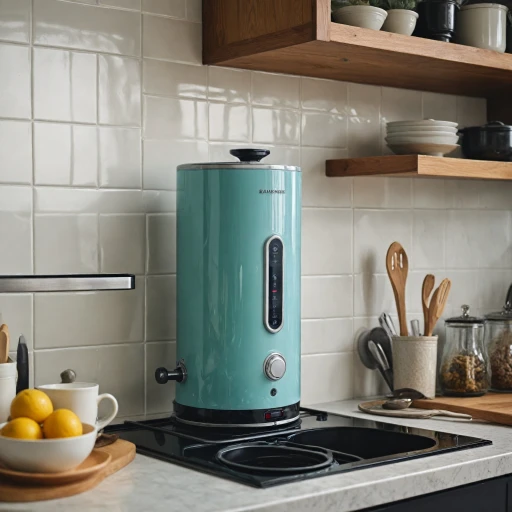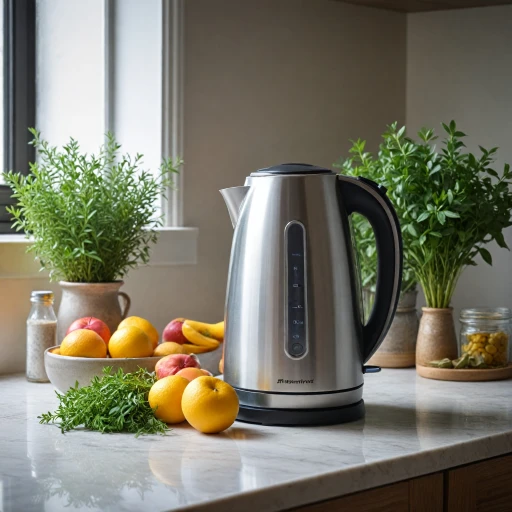Understanding Materials in Electric Kettles
Exploring the Materials of Electric Kettles
When it comes to choosing the best electric kettle for your home, understanding the materials used in its construction is crucial. The material of an electric kettle not only affects its durability and price but also its safety and potential impact on health. Let's delve into the most common materials you'll encounter.
Stainless Steel: A Popular Choice
Stainless steel is one of the most popular materials for electric kettles. It's known for its durability and resistance to rust and staining. Stainless steel kettles are often praised for their ability to heat water quickly and maintain temperature. However, it's important to ensure the stainless steel used is of high quality to avoid any toxic chemicals leaching into the boiling water. Look for kettles labeled as BPA free and food-grade stainless steel for the safest option.
Glass Kettles: Transparency and Purity
Glass electric kettles, often made from borosilicate glass, offer a visually appealing and plastic-free option. They allow you to see the water as it boils, which can be both practical and aesthetically pleasing. Glass is a non-toxic material, making it a great choice for those concerned about chemicals. However, glass kettles can be more fragile compared to their stainless steel counterparts.
Ceramic and Cast Iron: Traditional Alternatives
Ceramic and cast iron kettles bring a touch of tradition to modern kitchens. Ceramic tea kettles are typically free from toxic materials and offer an eco-friendly choice. They are known for retaining heat well, making them a good option for keeping water warm over time. Cast iron, while less common in electric models, is another durable and long-lasting material, though it can be heavy and more expensive.
Plastic Kettles: Considerations and Concerns
While plastic electric kettles are often more affordable, they come with concerns about chemicals leaching into the water, especially when exposed to high temperatures. If you opt for a plastic kettle, ensure it is BPA free and certified safe for boiling water. However, for those prioritizing a non-toxic tea experience, other materials may be preferable.
Understanding these materials will guide you in selecting a non-toxic electric kettle that suits your needs. As you explore features and benefits, consider how each material aligns with your priorities, whether it's eco-friendliness, durability, or price.
Features of a Non-Toxic Electric Kettle
Essential Features for a Health-Conscious Choice
When it comes to selecting an electric kettle that aligns with your health-focused lifestyle, consider the materials and features that prioritize safety and sustainability. With increasing awareness of potential chemical leaching, opting for a non-toxic electric kettle can contribute to a more eco-friendly and healthier kitchen environment.
Here are some key features to prioritize when choosing a kettle that ensures your boiled water remains unaffected by potentially harmful substances:
- BPA-Free Construction: Ensure the kettle is labeled as BPA-free to avoid chemical leaching commonly associated with plastics.
- Stainless Steel Interior: Look for models that boast a stainless steel or ceramic interior, known for their durability and resistance to absorption of toxins.
- Glass Kettle Options: Borosilicate glass kettles offer a clear view of the boiling process and ensure no chemicals from the materials seep into your water.
- Integrated Safety Features: An automatic shut-off function not only conserves energy but also prevents overheating, maintaining the longevity of your appliance.
- Temperature Control: Some kettles come with variable temperature settings, which are ideal for tea enthusiasts aiming to steep their preferred type of tea at the optimal temperature.
By focusing on these features, you can filter out kettles that do not meet the standards of toxic-free build, helping you achieve that great cup of tea. Remember, prioritizing healthier materials, such as stainless steel and glass, can make a significant difference. While the prices might vary, investing in a product that safeguards your health with these features is worthwhile.
Ultimately, the best electric kettle will not only heat water efficiently but also provide peace of mind with every cup you pour.
Benefits of Using a Non-Toxic Electric Kettle
Advantages of Opting for Non-Toxic Kettles
When it comes to choosing an electric kettle, safety and health considerations should be at the forefront. Non-toxic kettles bring numerous benefits that go beyond simply boiling water. One of the most significant advantages is the avoidance of harmful chemicals. Materials such as plastic often leach chemicals into your hot drinks, especially when subjected to high temperatures. By choosing plastic-free options or those labeled as BPA free, you ensure your peace of mind.Non-toxic electric kettles, made from materials like stainless steel, borosilicate glass, or ceramic, are often more durable and resilient to wear and tear compared to their plastic counterparts. Stainless steel and glass kettles are known for their excellent heat retention abilities, which ensures that your water remains hot for longer periods. This contributes to a more energy efficient heating process as well. Eco-friendly designs often incorporate materials that are either recyclable or naturally sourced, further reducing the environmental impact. For instance, a ceramic tea kettle not only exudes a classic aesthetic but can also provide a healthier boiling process.
Moreover, using a non-toxic kettle can enhance the taste of your tea. Materials like stainless steel and borosilicate glass do not impart any flavors, allowing the true essence of your tea to flourish. This is essential for tea enthusiasts seeking a pure and flavorful brew without the interference of toxic materials.
Exploring the best in the market, kettles like those from Great Jones come both stovetop and electric, offering a variety of options for every kitchen. Whether you prefer the quick efficiency of an electric kettle or the traditional feel of a stovetop kettle, there’s a safe, non-toxic option available. For more insights on choosing the right electric kettle, you can explore an in-depth exploration of American-made electric kettles to further inform your decision-making process.
Comparing Non-Toxic Electric Kettle Brands
Top Picks: Non-Toxic Electric Kettles
Ensuring safety and health are top priorities when selecting the best non-toxic electric kettle. Let's explore some of the most reputable brands renowned for producing eco-friendly and chemicals-free options.- Stainless Steel Kettles: A popular choice among those prioritizing safety, stainless steel tea kettles are widely recognized for their durability and resistance to rust or corrosion. These kettles typically have a stainless steel interior, ensuring no chemicals leach into the boiling water, making them an excellent option for health-conscious consumers. Their price range varies, providing options for both budget-friendly and high-end consumers.
- Ceramic Electric Kettles: Ceramic materials are free from harmful chemicals such as BPA, making them a safer choice for boiling tea. They are non-reactive and tend to maintain the purity of the water. While generally heavier than their steel counterparts, ceramic tea kettles earn praise for their unique designs and non-toxic features.
- Borosilicate Glass Kettles: Known for their durability and resistance to thermal shock, borosilicate glass kettles offer an appealing view of the water-boiling process. These kettles often come with stainless steel accents, ensuring no boiled water comes in contact with plastic components, thus maintaining its cleanliness and purity. The appliance's transparency and modern aesthetic make them a popular choice for those who value style and safety.
- Plastic-Free Options: A growing number of tea kettle manufacturers strive for plastic-free construction, focusing on stainless or ceramic as key materials. These products are ideal for those aiming to completely avoid potential toxins associated with heated plastics.
- Cast Iron Stovetop Kettles: Though not electric, stovetop kettles made from cast iron are another versatile choice for those focusing on long-lasting and classic designs. They retain heat exceptionally well and can be an interesting addition to a more traditional kitchen setting.
Maintenance Tips for Your Electric Kettle
Proper Care Tips for Longevity and Safety
Maintaining your electric kettle is essential to ensure both its longevity and the safety of your boiling water. Investing in a non-toxic electric kettle is just the beginning; proper upkeep will help maximize the benefits and protect your health. Here are some simple yet effective maintenance tips:- Regular Cleaning: Clean your kettle regularly to avoid buildup of limescale and other deposits. Use a mixture of equal parts water and vinegar for natural descaling. Allow it to sit in the kettle for around 15 minutes before rinsing thoroughly.
- Avoid Abrasives: When cleaning, avoid using harsh abrasives that could damage material surfaces like stainless steel or borosilicate glass. Instead, use a soft cloth or sponge.
- Keep the Exterior Shiny: For stainless steel kettles, a dab of olive oil can help keep it looking new and shining. Simply wipe it onto the exterior with a soft cloth.
- Check Filters: If your kettle has a removable filter, clean it periodically to ensure it’s free from deposits or clogging that can affect water flow and boiling efficiency.
- Be Mindful of Water Levels: Only boil the amount of water you need, as heating large volumes unnecessarily can stress the kettle’s heating elements, particularly in ceramic or glass models.
- Stay Plastic Free: If avoiding chemicals is a priority, adhere to using kettles free from plastic components, especially in the interior, to maintain safety and purity.
- Storage Solutions: Store your kettle in a dry place. Moisture around the electric base or plug can cause issues over time.
Common Myths About Electric Kettles
Debunking Common Misconceptions About Electric Kettles
When considering the purchase of an electric kettle for boiling water, there are several myths that may influence your decision. Let's address some of these misconceptions to help you make an informed choice.
- All plastic kettles are unsafe: While it's true that many prefer stainless steel, glass and ceramic materials due to concerns about chemicals, not every plastic kettle is necessarily a health hazard. Look for BPA-free models.
- Stovetop kettles are superior to electric ones: Although stovetop kettles have their classic charm, electric kettles offer quicker and more convenient boiling, making them ideal for busy lifestyles.
- Stainless steel kettles are prone to rust: High-quality stainless steel is resistant to rust. Regular cleaning and maintenance, as discussed earlier, can prevent potential issues.
- Glass kettles are fragile: While glass might seem more fragile, many modern electric kettles use borosilicate glass, which is sturdy and safe for daily use.
- You can only heat water in an electric kettle: Many electric kettles designed today are multipurpose, allowing you to brew not just tea but also coffee or even warm beverages like soup.
- Electric kettles are expensive: While specialty kettles can come with a higher price tag due to advanced features, there are plenty of affordable options that still provide safety and efficiency.
Understanding these myths allows you to make a well-grounded decision. Remember, choosing the right kettle involves looking at the materials and features that best fit your needs and preferences.



